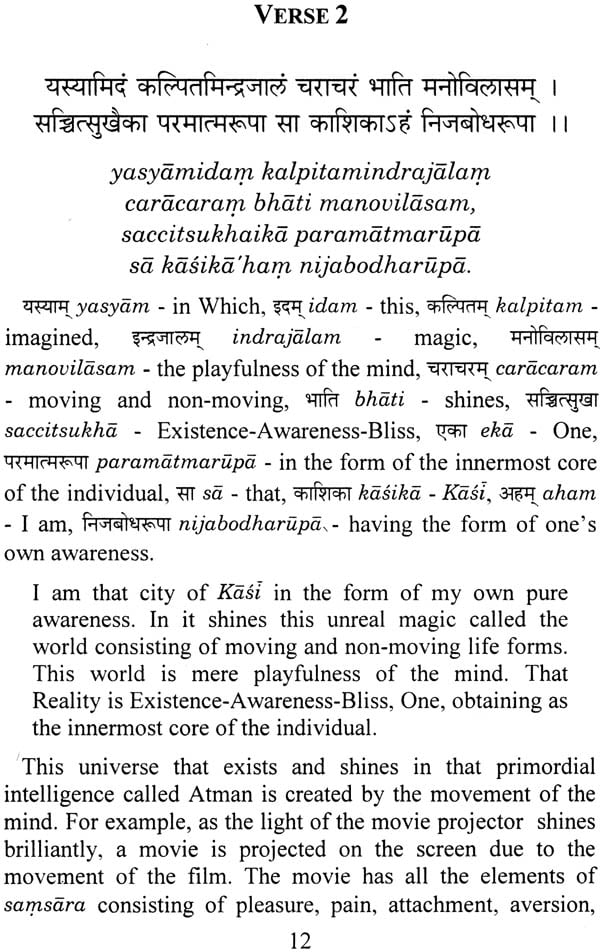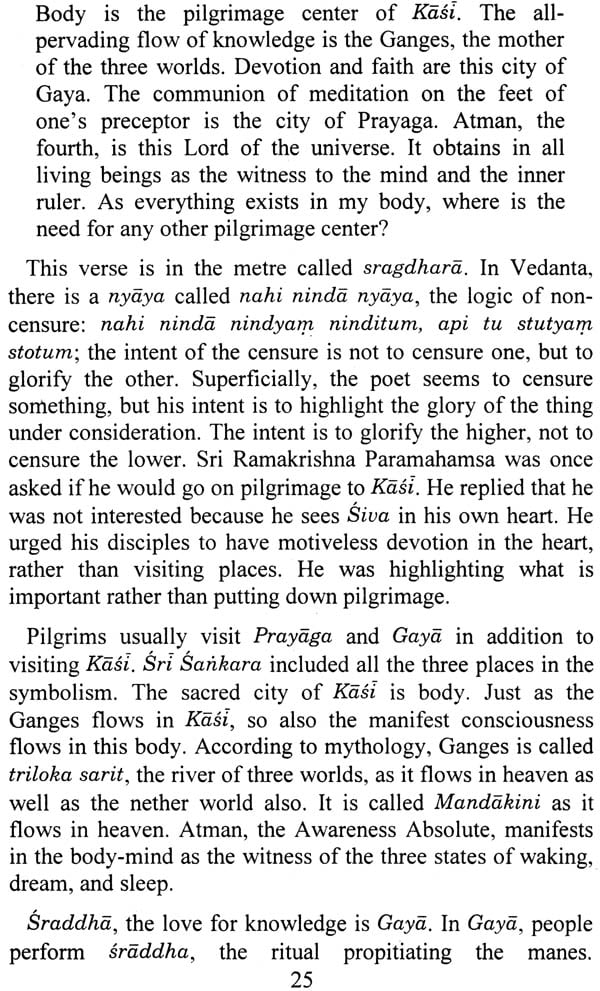
Kasi Pancakam with The Commentary of Tattvaprakasika
Book Specification
| Item Code: | NAK998 |
| Author: | Swami Tattvavidananda Saraswati |
| Publisher: | BRAHMA VIDYA KUTEER |
| Language: | Sanskrit Text with Transliteration and Word to Word Meaning English Translation |
| Edition: | 2009 |
| Pages: | 34 |
| Cover: | Paperback |
| Other Details | 8.5 inch x 5.5 inch |
| Weight | 60 gm |
Book Description
There are three' aspects to any dharma: karma or rituals, upasana or mental worship, also called bhakti or devotion, and jnana or philosophy. All these three aspects are beautifully integrated in Hindu Dharma. In the western culture, however, we find that philosophy is distanced from religion, which is limited to rituals and devotion. Even great philosophers like Aristotle did not contribute to religion and, in fact, some of them like Bertrand Russell and Nietchze have spoken against organized religion. We find a marvelous synthesis of philosophy and religion in Hindu Dharma. Here, religion is not opposed to philosophy, and philosophers are not against religion. For example, even though Sri Sankara is dedicated to jnana, yet, he accommodates karma with certain restrictions. Needless to say, no philosopher can accommodate nisiddha karma or prohibited action. Sri Sankara does not accommodate kamya karma, ritual prompted by desire, either. Even in the Gita, kamya karma is denigrated and rejected outright without any hesitation. The nitya karma, duty-based action, on the other hand, is beautifully integrated into yoga, the means of communion with God or the pursuit of Self-knowledge.
One's life is a life of action and therefore, karma has to be integrated properly into Self-knowledge. Karma has the quality of perpetuating itself and the rituals have grown very unwieldy over time. Philosophy cannot accommodate all of these karmas. For example, the Kaivalyopanisat (3) says, na karmana na prajaya dhanena tyagenaike amrtatvamanasuh. it is through renunciation that a few have attained immortality, not through rituals, progeny, or wealth. If ritualism is divorced from the doctrine of philosophy, it becomes mechanical, repetitive, and dulls the mind. Karmas practiced with the right attitude of duty and devotional offering are nicely integrated into philosophy as karma yoga, a means of purifying the mind. As sri Sankara repeatedly points out, karma yoga is a wonderful means to neutralize phalabhisandhi, the attachment towards the results of actions.
Normally, we have so much attachment to the result, which fructifies in the future, that we tend to justify any means to achieve it. Since the mind cannot be committed to two things at the same time, our commitment to the result impact-s our commitment to the means. It is the means that shapes the end, and karma yoga is an attitude of action without an attachment to the result. This attitude is described in the Gita (6-1) as anasritah karmaphalam karyam. karma karoti yah. the one who performs action that is to be done, not driven by the result thereof. The striver has to perform nitya and naimittika karma, duties to be fulfilled daily and on occasion, without seeking the results thereof.
Bhakti, devotion, which includes mythology, is also well integrated into Hindu philosophy. For instance, the Gita (14- 26) says, mam. ca yo'vyabhicarena bhaktiyogena sevate, sa gunan samatityaitan brahmabhuyaya kalpate; whosoever worships Me with unwavering yoga of devotion, he transcends these gunas (sattva, rajas, and tamas) and becomes eligible to become Brahman. This is niskama bhakti, motiveless devotion. It helps one gain Self- knowledge. Again, if devotion is not validated by doctrinel philosophy, it becomes superstitious and does not help elevate the devotee. It has to become yoga.
| Introduction | 1 |
| Verse 1 | 5 |
| Verse 2 | 12 |
| Verse 3 | 15 |
| Verse 4 | 20 |
| Verse 5 | 24 |
| Index | 29 |









